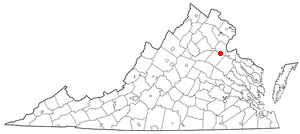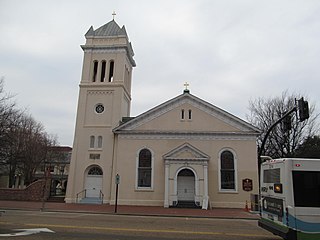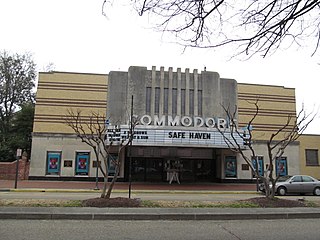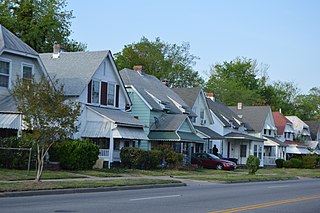
United States Lightship 101, now known as Portsmouth as a museum ship, was first stationed at Cape Charles, Virginia. Today she is at the Portsmouth Naval Shipyard Museum in Portsmouth, Virginia. Portsmouth never had a lightship station; however, when the vessel was dry docked there as a museum, she took on the pseudonym Portsmouth. A National Historic Landmark, she is one of a small number of surviving lightships.

This is a list of the National Register of Historic Places listings in Albemarle County, Virginia.

This is a list of the National Register of Historic Places listings in Chesterfield County, Virginia.

This is a list of the National Register of Historic Places listings in Henrico County, Virginia.

This is a list of the National Register of Historic Places listings in Frederick County, Virginia.

This is a list of the National Register of Historic Places listings in Fredericksburg, Virginia.

This is a list of the National Register of Historic Places listings in Portsmouth, Virginia.

St. Paul's Catholic Church is a historic Roman Catholic church located in Portsmouth, Virginia, United States. It is a compact Gothic Revival style, cruciform plan church. It is constructed of load-bearing masonry walls clad in quarry-faced granite. The church was designed by John Peebles (1876-1934) in 1897, and dedicated in 1905. It is the fifth church on the site. Also on the property is a contributing rectory constructed in 1913.

The Oakwood–Chimborazo Historic District is a national historic district of 434 acres (176 ha) located in Richmond, Virginia. It includes 1,284 contributing buildings, three contributing structures, five contributing objects and four contributing sites. It includes work by architect D. Wiley Anderson. The predominantly residential area contains a significant collection of late-19th and early-20th century, brick and frame dwellings that display an eclectic mixture of Late Victorian, Queen Anne, and Colonial Revival styles.

Madison County Courthouse Historic District is a national historic district located at Madison, Madison County, Virginia. The district encompasses 66 contributing buildings in the county seat of Madison. In addition to the separately listed Madison County Courthouse, there are a variety of residential, commercial, and institutional buildings dating from the early 19th to the 20th century. Notable buildings include the County Clerk's Office (1832), the Washington Tavern or Eagle House, the Arcade (1830s), Piedmont Episcopal Church (1832-1834), the Madison Presbyterian and Methodist churches (1852-1853), Hunton House Hotel, and the Linn Banks Masonic Lodge (1855).

Monumental United Methodist Church, formerly known as Dinwiddie Street Methodist Church, is a historic Methodist church located in Portsmouth, Virginia. It is a five-bay brick and stucco, Victorian Gothic style church. It is features a 182 feet tall, two part central tower. The church was built between 1871 and 1876 on the foundations of an earlier 1831 building that had burned in 1864.

Trinity Episcopal Church is a historic Episcopal church located in Portsmouth, Virginia. It was built between 1828 and 1830, and is a stuccoed brick building. It has an attached bell tower. Also on the property is the contributing parish house, built in 1887. During the American Civil War, the church was used as a hospital.

Portsmouth Courthouse, also known as Norfolk County Courthouse, is a historic courthouse building located at Portsmouth, Virginia, United States. It was built in 1846, and is a one-story with basement, Greek Revival style brick building. It measures 78 feet wide by 57 feet deep. The building is topped by a paneled parapet with Doric order entablature supported by plain Greek Doric pilasters. The building remained in use as a courthouse until 1960, when the county government moved to Great Bridge.

Commodore Theatre is an historic movie theater located at Portsmouth, Virginia. It was built in 1945 in the Streamline Art Deco style, and originally sat 1,000 people. The theater closed in 1975 and sat empty until a change in ownership and extensive renovation beginning in 1987. It reopened two years later, and as of 2023 was in operation displaying first-run films accompanied by a full kitchen.

Portsmouth Olde Towne Historic District, is a national historic district located at Portsmouth, Virginia. It encompasses 89 buildings. It is located in the primarily residential section of Portsmouth and includes a notable collection of Federal and Greek Revival style townhouses, known as "basement houses." Other notable buildings include the Watts House (1799), Grice-Neeley House, Ball-Nivison House (1752), Emanuel African Methodist Episcopal Church (1857), St. John's Episcopal Church (1898), Court Street Baptist Church (1901-1903), and Union Machinist Home. Located in the district is the separately listed Monumental Methodist Church.

Cradock Historic District is a national historic district located at Portsmouth, Virginia. It encompasses 759 contributing buildings and 1 contributing structure in a primarily residential section of Portsmouth. It was developed starting in 1918, as a planned community of Colonial Revival and Bungalow style single family residences. It was developed by the United States Housing Corporation as a result of the rapid influx of workers at the Norfolk Naval Shipyard during World War I.

Truxtun Historic District is a national historic district located at Portsmouth, Virginia. It encompasses 241 contributing buildings in a primarily residential section of Portsmouth. It was developed between 1918 and 1920 as a planned community of Colonial Revival style single family residences. It was developed by the United States Housing Corporation as a result of the rapid influx of workers at the Norfolk Naval Shipyard during World War I. It was the first wartime government housing project constructed exclusively for African-American residents. In 1921 the Federal Government sold it off.

Port Norfolk Historic District is a national historic district located at Portsmouth, Virginia. It encompasses 621 contributing buildings and 1 contributing site in a primarily residential section of suburban Portsmouth. It was developed between about 1890 and 1910, and includes notable examples of Queen Anne, Bungalow / American Craftsman, and American Foursquare style single family residences.

Downtown Portsmouth Historic District, also known as the High Street Corridor Historic District, is a national historic district located at Portsmouth, Virginia. It encompasses 229 contributing buildings, 1 contributing site, 4 contributing structures, and 1 contributing object in the central business district of Portsmouth. The district encompasses the original 1752 plan of the Town of Portsmouth and includes portions of expansions of the original boundaries dating to 1763 and 1909. It includes a variety of commercial, government, and institutional buildings, with most dating to the years around the turn of the 20th century. Notable buildings include the Captain Baird House, Vermillion Manor (1840), City Hall Building (1878), former United States Post Office (1907-1908), First Presbyterian Church (1877), First United Methodist Churches (1882), St. James Episcopal Church, Ebenezer Baptist Church, YMCA building, Tidewater Building, Southern Aid Building, Colony Theater, Lyric Theater, Blumberg's Department Store, Mutual Drug Company (1946), the New Kirn Building, and the Professional Building. Separately listed are the Commodore Theatre, Portsmouth Courthouse, Pythian Castle, St. Paul's Catholic Church, and Trinity Episcopal Church

Southwest Historic District is a national historic district located at Roanoke, Virginia. It encompasses 1,547 contributing buildings constructed between 1882 and 1930 in the Roanoke neighborhoods of Old Southwest, Mountain View, and Hurt Park. It is a primarily residential district with houses in a variety of popular late-19th and early-20th century architectural styles. The district also includes a small number of commercial structures, churches, and two schools.






















